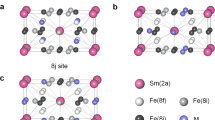Abstract
Although the natural remanent magnetization of terrestrial igneous rock is often due to multidomain grains of magnetite or titanomagnetite, it is not certain what controls the coercivity of the multidomain grains and hence the stability of their remanence1. Even the related but simpler problem of what controls the bulk coercive force Hc of multidomain magnetite is still not solved. I consider this simpler problem here by noting2,3 that the coercive force of multidomain magnetite powders4 varies with low temperature approximately in proportion to the magnetostriction5 coefficient λ. I find the same approximate proportionality between Hc and λ on cooling six igneous rocks bearing multidomain magnetite. Hence, the coercive force of these powders and rocks seems mainly to be magnetostrictively controlled–presumably through internal stresses. This is even true of the three rocks with high enough Hc (∼150 Oe) to be classed as pseudo-single-domain, including two with the fine magnetite–ilmenite intergrowths often observed in terrestrial igneous rocks with stable remanence6.
This is a preview of subscription content, access via your institution
Access options
Subscribe to this journal
Receive 51 print issues and online access
$199.00 per year
only $3.90 per issue
Buy this article
- Purchase on Springer Link
- Instant access to full article PDF
Prices may be subject to local taxes which are calculated during checkout
Similar content being viewed by others
References
Dunlop, D. J. Phys. Earth planet. Inter. 26, 1–26 (1981).
Hodych, J. P. Bull. int. Ass. Geomagn. Aeron. 45, 255 (1981).
Hodych, J. P. Can. J. Earth Sci. 19, 144–152 (1982).
Morrish, A. H. & Watt, L. A. K. J. appl. Phys. 29, 1029–1033 (1958).
Bickford, L. R. Jr, Pappis, J. & Stull, J. L. Phys. Rev. 99, 1210–1214 (1955).
Larson, E. E., Ozima, M., Ozima, M., Nagata, T. & Strangway, D. W. Geophys. J. R. astr. Soc. 17, 263–292 (1964).
Syono, Y. Jap. J. Geophys. 4, 71–143 (1965).
Träuble, H. in Magnetism and Metallurgy (eds Berkowitz, A. E. & Kneller, E.) 621–687 (Academic, New York, 1969).
Stacey, F. D. & Wise, K. N. Aust. J. Phys. 20, 507–513 (1967).
Parry, L. G. Phil. Mag. 11, 303–312 (1965).
Lowrie, W. & Fuller, M. J. geophys. Res. 74, 2698–2710 (1969).
Day, R., Fuller, M. D. & Schmidt, V. A. J. geophys. Res. 81, 873–880 (1976).
Néel, L. Annls Univ. Grenoble 22, 299–343 (1946).
Pauthenet, R. C.R. hebd. Séanc. Acad. Sci., Paris. 230, 1842–1843 (1950).
Bhagavantam, S. Proc. Ind. Acad. Sci. A41, 72–90 (1955).
Hodych, J. P. Bull. int. Ass. Geomagn. Aeron. 45, 223 (1981).
Author information
Authors and Affiliations
Rights and permissions
About this article
Cite this article
Hodych, J. Magnetostrictive control of coercive force in multidomain magnetite. Nature 298, 542–544 (1982). https://doi.org/10.1038/298542a0
Received:
Accepted:
Issue Date:
DOI: https://doi.org/10.1038/298542a0
This article is cited by
Comments
By submitting a comment you agree to abide by our Terms and Community Guidelines. If you find something abusive or that does not comply with our terms or guidelines please flag it as inappropriate.



